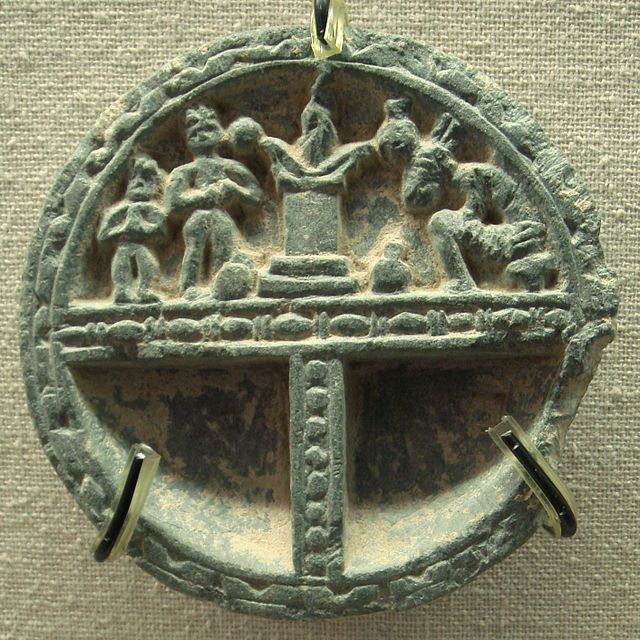热门问题
时间线
聊天
视角
印度-帕提亚王国
来自维基百科,自由的百科全书
Remove ads
印度-帕提亚王国,又称苏伦王国,[2]是由伊朗七大家族的苏伦家族中的一个分支 - 冈多法勒斯一世所建立的帕提亚人王国。他们极盛时期的统治地区涵盖伊朗东部、阿富汗地区多处、以及印度次大陆西北地区(现代巴基斯坦的部分,加上印度西北部)。
印度-帕提亚王国建立于19年,当时苏伦王国的统治者冈多法勒斯一世担任兰德加纳(即锡斯坦)的总督,他宣布脱离安息帝国而独立。后来他向西征战,从印度-斯基泰人和印度-希腊人手中夺取领土,而将他的王国变成一个帝国。[3]在1世纪下半叶,印度-帕提亚王国受到贵霜帝国入侵,领土大幅减少。但仍保留锡斯坦地区的控制权,这个王国最后在约224年/225年被波斯的萨珊王朝征服。[4]
印度-帕提亚王国以建造佛教塔克特依巴依僧院而闻名。这所僧院在1980年被联合国教育、科学及文化组织列入世界遗产。
Remove ads
历史


冈多法勒斯一世起初似为今伊朗东部锡斯坦的统治者。他可能是印度-斯基泰人统治者阿帕拉卡拉加斯的附庸,或者是统治者的亲戚。他大约在公元前20年到10年,[6]把阿帕拉卡拉加斯的王国征服,发生的时间也许是在印度-斯基泰人重要统治者亚齐斯一世过世之后。冈多法勒斯一世所控制的领土包括阿拉霍西亚、锡斯坦、信德、旁遮普、和喀布尔山谷,但他的领土似乎并没包括旁遮普东部以外的土地。[7]冈多法勒斯一世自称称为“万王之王”,这是一种安息帝国头衔,显示这个印度-帕提亚王国只是一个松散的框架,而在框架之下仍有许多较小的王朝,保有自己的领土,它们的臣服可能只是为换取来自冈多法勒斯及其继任者的认可。这些较小的王朝包括阿帕拉卡拉加斯本身、印度-斯基泰人的总督(如锡安尼斯和拉吉乌拉),以及不知名的的印度-斯基泰统治者(因这些人仿铸亚齐斯一世的钱币)。印度-斯基泰人的西萨特拉普王朝也在古吉拉特邦占主导地位,也许这个恰好就在冈多法勒斯的势力范围之外。
冈多法勒斯一世过世之后,他的王国开始分裂。“冈多法勒斯”(或是名字,或是头衔)由沙佩东尼斯(或许是冈多法勒斯之子)继承,称为冈多法勒斯二世。虽然沙佩东尼斯自称是主要统治者,但他的政权并不稳固,他曾在信德、旁遮普东部、和阿富汗南部的阿拉霍西亚零星的铸造过钱币。最重要的继任者应该是贡多法列斯的侄子阿巴达哥希斯一世,他统治的领土包括旁遮普,可能还包括根据地锡斯坦。沙佩东尼斯的统治时间不长,沙佩东尼斯似乎由奥尔塔涅斯接替,后者成为冈多法勒斯三世。到公元20年后,由一位名为萨希斯(也称为冈多法勒斯四世萨希斯)的国王统治。根据《印度-帕提亚王朝钱币及历史(Indo-Scythian coins and history)》一书的作者Robert C. Senior的说法,这位萨希斯就是塔克特依巴依僧院铭文中所提到的冈多法勒斯。[8]

王朝还有有一些不甚知名或是不知名统治者,可从他们铸造的钱币获得些许的资讯。
但日后印度-帕提亚王国继承者未能再取得如开国者冈多法勒斯一世所开创的地位,公元1世纪中期,王国在印度北部的领土受丘就却治下的贵霜帝国并吞。印度-帕提亚王国设法保住锡斯坦,直到萨珊王朝推翻安息帝国后,再把这个王国征服。[9]
Remove ads
考古研究

古城塔克西拉被认为是印度-帕提亚王朝的首都。约翰·马歇尔爵士在这里曾做过较大面积地层的挖掘工作,挖出相当数量带有帕提亚风格的文物。遗迹附近的建戴尔庙宇,被推定为印度-帕提亚王国时代祆教的火神庙。
一些古代著作提及这个地区有印度-帕提亚人的存在,例如使徒多马的故事,他被聘为木匠,到印度国王“古德纳法尔(Gudnaphar)”(被认为就是冈多法勒斯)的宫中工作。《多马行传》第17章描述多马前往印度北部拜见古德纳法尔国王;第2章和第3章描述多马经过海路前往印度,从而推论他是在公元52年抵达印度的西岸。
Robert C. Senior指出,[10]这位古德纳法尔国王通常被认为是第一任的冈多法勒斯,而这位冈多法勒斯的存在是在基督教出现之后,而根据Senior的研究表显示历史上第一位冈多法勒斯在公元1年之前即已存在。因之多马可能拜见的是另一位拥有相同名讳的国王。


希腊智辩家菲洛斯塔图斯所撰写的提亚纳的阿波罗尼乌斯行传,书中提起这位希腊哲学家提亚纳曾在公元46年左右到过印度,特别是到塔克西拉。并提起存在塔克西拉的希腊式的建筑,[11]可能指的是锡尔卡普这个地方,并说在塔克西拉的印度-帕提亚国王之名为法拉提斯,国王自幼在宫廷接受希腊教育,能说流利的希腊语:
- “国王,请告诉我,您是如何能说那么流利的希腊语,并培养出您的哲学素养的?” [12]
- [...]-“在我受过希腊教育之后,我的父亲在我年纪很小,大约是十二岁时,就带我去饱学之士那儿,学者待我像亲生一般的教导;他们特别钟爱通晓希腊语的人,而且认为我和他们的性格相似,是他们的同类。” [13]
《爱利脱利亚海周航记》是本由公元1世纪流传下来的游记,描述古代在阿拉伯海的航行路线,书中描述帕提亚国王们在信德地区互相征战,而这个地区从前就被印度斯基泰人统治过:
- “这条河有7处河口,都非常浅,布满泥泞,除中部的1处之外,其他的都无法通航。中部河口岸边有座名叫巴卡力坎的镇集,镇集前方有座小岛,而往内陆方向有座叫明纳加拉的斯基提亚城市。这座城市由几位帕提亚王子所控制,但他们之间经常会发生斗争,胜者把对方驱离。” [14]
塔克特依巴依的铭文中记有两个日期,其中之一是Maharaja Guduvhara帝王纪元26年(推测为一位冈多法勒斯),另一是未知纪元的103年[15]
Remove ads
印度-帕提亚王国宗教

我们对苏伦家族的宗教信仰仍然不知,但我们知道他们和信奉祆教的安息帝国存有宗教冲突。[16]印度-帕提亚王国统治者与印度-希腊人或印度-斯基泰人不同,没有他们支持佛教的明确记录 - 例如宗教奉献、铭文、甚至是传说故事。同样的,虽然印度-帕提亚王国钱币紧密沿袭希腊钱币系统,但其上从未显示过佛教的佛教三宝符号(除了后来的萨希斯钱币),也从未使用过大象或公牛的图案,这两种可能是宗教的符号,被他们之前的人大量使用。人们认为他们是伊朗人,也保留祆教的信仰。这伊朗人的神话系统后来由贵霜帝国继承,贵霜帝国透过位于现在巴基斯坦的白沙瓦-开伯尔-普什图地区的政府统治其帝国。
印度-帕提亚人宗教信仰表达

在印度-帕提亚人的钱币和健驮逻国的艺术品上,印度-帕提亚人被描绘成穿有短的敞胸外套和宽松的大裤脚,可能还在裤管上加有套裤。[20]他们的外套上装饰著成排的装饰环或徽章。这些人的头发通常很浓密,并绑有束发带,这是公元1世纪以来帕提亚人广泛采用的装扮。[21]
在佛教灵修场景中,有时会有穿着印度-帕提亚人服饰的演员。通常对约翰·马歇尔爵士在塔克西拉附近的锡尔卡普所发掘出的大多数物件,都认为与印度-帕提亚时代层有关,但最近的学术研究有时会将他们列为与印度-希腊人有关联。[22]这些考古挖掘出某种数量的希腊化文物,它们结合有佛教崇拜(窣堵坡)的元素。其他一些神庙,例如在建戴尔附近的,可能是被作为祆教的火神庙使用。
佛教雕塑
在锡尔卡普发现的雕像显示印度-斯基泰晚期至印度-帕提亚层(第2层,公元1年到60年)期间,在印度-帕提亚人统治时或甚至是统治之前,健驮逻艺术已十分发达。各式的雕像中有古希腊神像到各种平民信徒,其中有被认为是早期佛陀和菩萨的雕像。目前尚不知健驮逻国的希腊式佛教艺术何时出现,但锡尔卡普的发现确实表明,这种艺术在贵霜帝国出现之前,已有高度发展。
石材彩妆托盘
在发现的众多健驮逻国石材彩妆板被认为是印度-帕提亚时期的艺术代表。这些彩妆板结合希腊和波斯的影响,以及代表作品中的人物正面外观,被认为是帕提亚艺术的特征。这些彩妆板仅在对应于印度-希腊王国、印度-斯基泰王国、和印度-帕提亚王国的考古层中发现,而在他们之前的孔雀王朝层或后续的贵霜帝国层中并未存在。[23]
这些彩妆板通常刻有神话场景中穿着希腊服饰的人,但其中有些人是穿着帕提亚风格服饰的人(头上绑有束发带、穿露胸外套及宽松的裤子、佩戴珠宝\皮带)。捷克布拉格纳普斯泰克博物馆收藏有一彩妆板,显示一位印度-帕提亚国王盘腿坐在一张大椅上,旁有两名穿着帕提亚服饰的仆人。是仆人侍奉主子品尝葡萄酒的场景。
-
狩猎
-
狂欢
-
一对夫妇
Remove ads
佛教经由丝绸之路传播

即使萨珊王朝在公元226年占领印度-帕提亚人的领土,仍有些小块的印度-帕提亚人统治地继续在东方存在。从公元2世纪开始,一些中亚佛教僧侣出现在中国的大城市,如洛阳,甚至是南京。最早将佛教经书译成中文的翻译者实际上是印度-帕提亚僧侣[来源请求],他们的翻译功力卓越。这些僧侣的中文姓氏以“安(An)”来表达他们是来自“Anshi”安息帝国。
Remove ads
主要统治者


参见
参考资料
外部链接
其他资料来源
Wikiwand - on
Seamless Wikipedia browsing. On steroids.
Remove ads




